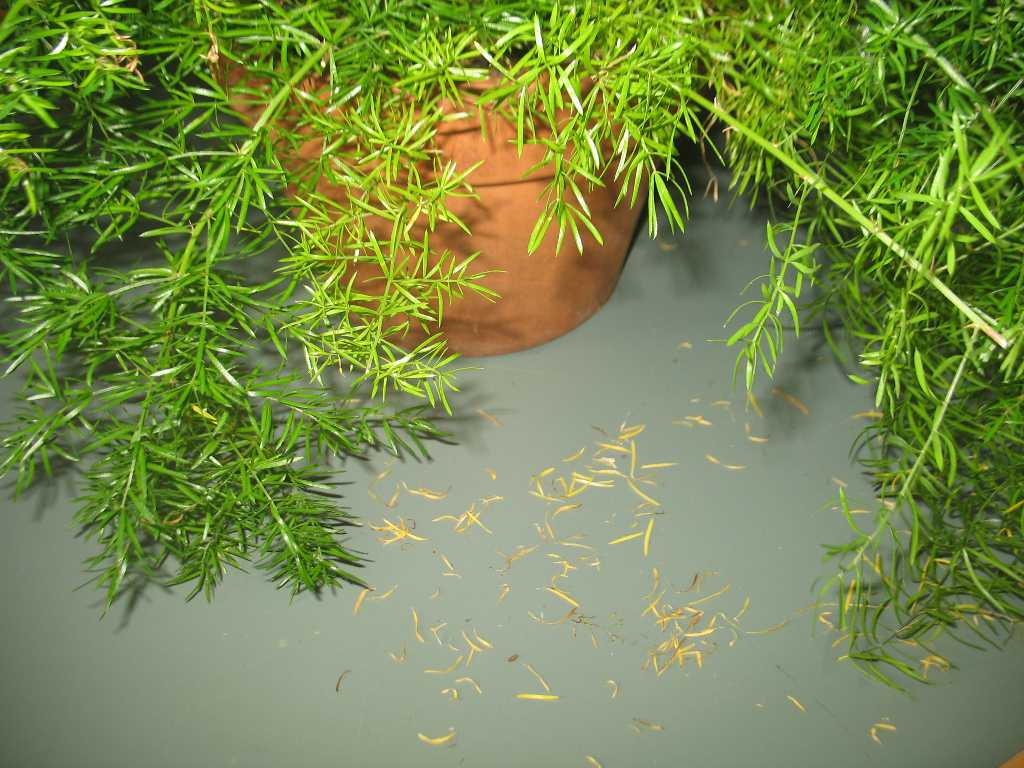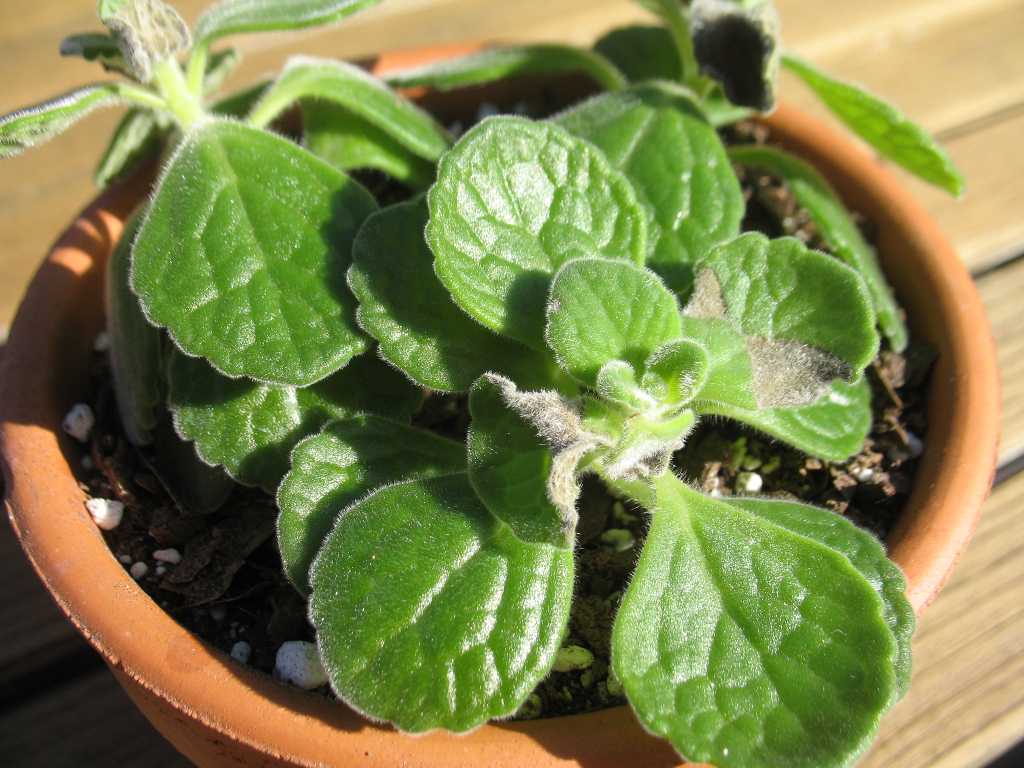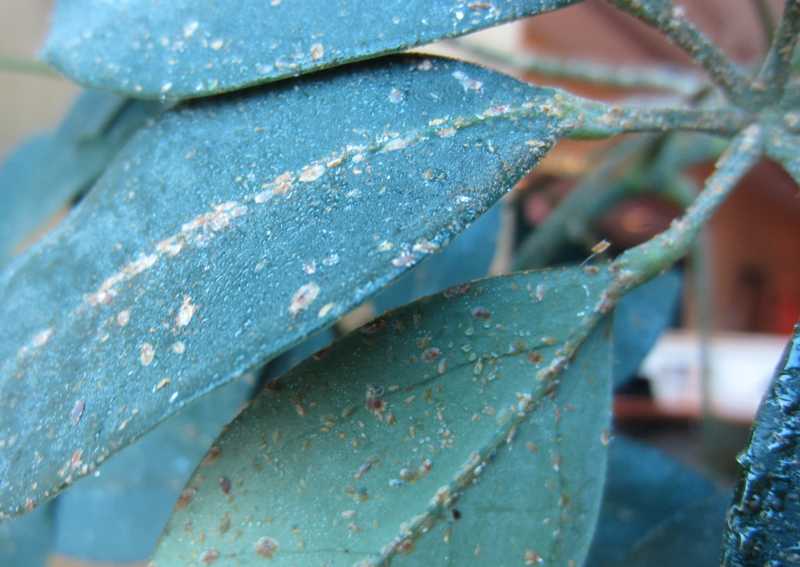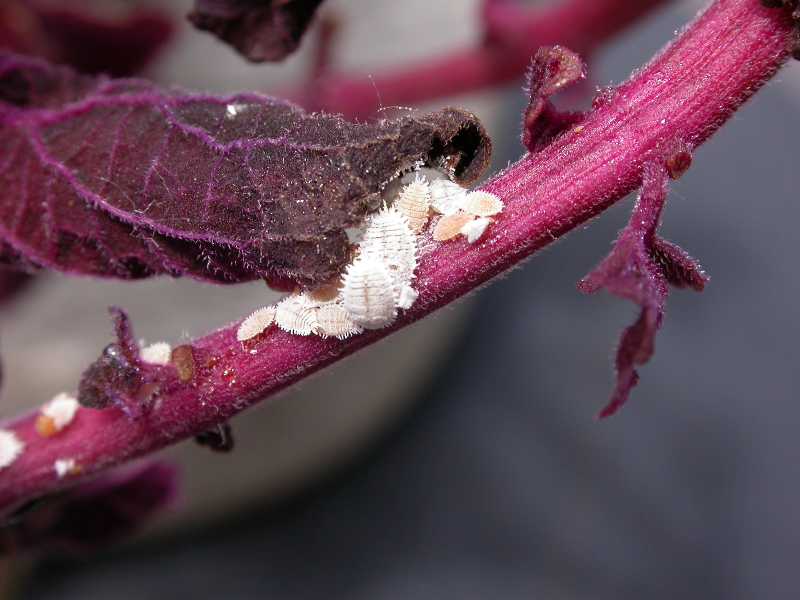Environmental Conditions
|
|

Too dry
Decline of plants kept too dry is very common. Wilting leaves, slight drooping or an off color can signal a plant is getting too dry. Learn when and how to water plants correctly. For small pots a quick and easy guide is to lift the pot. If it is light, it is in need of water. Don't be afraid to tip a plant out of its pot to examine its roots while you learn to water correctly. Beware, once the soil in a pot gets very dry it may need to be soaked to get it properly wetted again. Even if watered, the plant may be on a spiraling course of decline and may not recover after the period of drought.
|
|

Overwatering
Some people say more plants are killed by overwatering than anything else. Learn how to water properly. Wilted leaves may indicate the soil is too dry OR too wet - rotting roots cannot take up water! Plants may have dull, light green or yellowing leaves. Roots are brown and soft. The soil at the bottom of the pot may be wet and release bad odors. Having plants standing in water or growing in pots without drainage holes is asking for trouble. Repot if plants are growing in a pot without drainage.
|
|

Sunburn
Leaves or tissues turn brown or tan on the side of the plant directly aligned with the sun. This pattern is a good indicator of sunburn. In may cases the plant will still grow but may be stunted for a while. Move the plant out of direct sunshine. Remove the damaged tissues.
|
|

Too little light
Plants not receiving enough light often have light green foliage and begin to stretch or lean towards the light. Some plants will also drop older leaves. Read about your plants to learn their light requirements. Plants growing outdoors for the summer and wintered indoors rarely receive the amount of light they want and will invariably drop leaves.
|
|

Salt build-up
As plants are watered and fertilized, salts and other chemicals build up in the soil. At high levels, a typical reaction is for the tip or edge of leaves to turn yellow or brown and slowly die. To reduce salt build-up, regularly place pots in a sink and run water through the pot 3-4 times to help "wash out" the salts. Repot regularly.
|
|

Leaf and flower drop
Any stress, such as lack of water, overwatering, temperature change, reduction of light or relocating of a plant can result in leaf and/or flower drop. It is a very common initial reaction to a stress placed on the plant. If the cause is not drought or overwatering, the plant may slowly adapt to the new location. Leaf drop is often a certainty when plants are brought indoors after being summered outdoors. Less light, lower humidity and hot air from indoor heating will result in leaf and/or flower drop.
|
|

Oedema
Odema is a physiological disorder that develops when roots take up water faster than it can be used by the plant or transpired through the leaves. Water pressure builds up in the internal cells of the leaves causing them to burst, leaving dead cells that are visible as a blister, primarily on the undersides of leaves. It is often the result of erratic watering. It can be confused with scale or other insects or even disease.
|
|

Chilling injury
Exposure to chilling temperatures, even if not freezing, can damage tropical, subtropical as well as other plants. Dropping, wilting or discolored leaves or spots on leaves can be signs of chilling injury. If not severe, damaged foliage may be able to be removed and the plant will survive. Tropical plants growing in extended periods of cold temperatures may lose vigor, be stunted, turn yellow and die. Wet soil and cold temperatures often lead to root rots.
|
| |
|
|
Insects
|

Spider mites
Early symptoms may include stippled, yellowing and dirty leaves and webbing around flower buds and leaf tissue. Severe infestations can lead to leaves dropping or drying out completely. The mites (technically not insects) are about the size of pepper grains and can be found on the leaf tissue and in the webbing. |
|

Scale
Scale infested leaves may turn yellow and drop. On leaf or stem surfaces, white, brown, grey or reddish cushion-like to scaly bumps can be easily detected and removed. The canopy of leaves, table and floor may be sticky.
|

Aphids
Symptoms include twisted growth, changing foliage color and smaller leaves. Soft-bodied insects about 1/8” can be detected clustering on the tip of the plants and the underside of leaves. The canopy of leaves, table and floor may be sticky.
|
|

Mealybug
Plants with white cottony or waxy insects on the surface of leaves and stems or in leaf axils are most likely infested with mealybugs. They are easy to spot and common on many indoor plants.
|

Whiteflies
Mottled and yellow leaves with tiny winged insects and scale-like larvae on the lower surface may be detected on infested plants. When disturbed, winged adults will fly in a "cloud of white". |
|

Thrips
Thrips are rarely seen because of their small size. These insects feed by rasping the surface of the plant parts with their single large mandible and slurping the plant juices that seep from the wound. Flowers or leaves may develop silvery streaks. Heavily infested leaves appear brownish or silvery, and growing points may become contorted. They also favor opening flower buds.
|

Fungus gnats
Dead seedlings and unhealthy roots may be caused by a fungus gnat infestation. These 1/8" dark winged adults are harmless and fly when disturbed but it is the black headed larvae in the soil that feed on plant roots or decaying organic material in the soil. |
|
|
| |
|
|
Diseases
|

Powdery mildew
The upper surface of leaves, stems and flowers develop a white powdery growth. Prune off affected foliage and increase air movement around the plants. |
|

Grey mold
Leaves and/or flowers develop a white growth, which later turns a dark gray. This disease will spread by wind and water. Discard the faded flowers and maintain good sanitation. Improve air circulation around the plants.
|

Rots
Root rot is most often the result when a plant is overwatered or the plant is grown in too large a pot or a pot with inadequate drainage. Turning the plant out of the pot and examining the roots can confirm the condition. Above ground parts can also develop rots. It is best to dispose of plants with root rots but plants with just a stem or small part of the plant with a rot, may be salvaged by pruning out the rotted part. A plant with root rot may be a candidate for rooting stem cuttings of unaffected shoots. |
|

Viruses
The classic symptoms of viruses is mottled foliage or ring-spots. Since viruses circulate internally in the plant, no treatment is effective to rid the plant of the virus. Once a plant is diagnosed with a virus, it is best discarded as many viruses can infect a wide range of plants.
|
| |
|
|
Nutrient Deficiencies
|

Iron-deficiency
The classic symptom of iron deficiency is new leaves turning yellow but the veins remaining green. It is most prevalent on new, upper growth but eventually the whole plant may be affected. This is most common on plants that require an acid soil, such as azaleas.
|
|

John Ruter, University of Georgia, Bugwood.org
Nitrogen deficiency
The oldest leaves turn yellow at the margins and progress inward, which may lead to defoliation and reduced growth. When severe, only the new growth remains green while the rest of the foliage is yellow. An application of a fertilizer with nitrogen can give quick green-up effects.
|